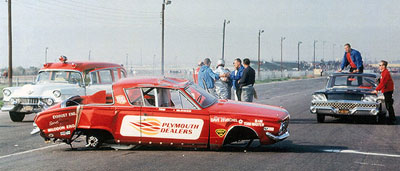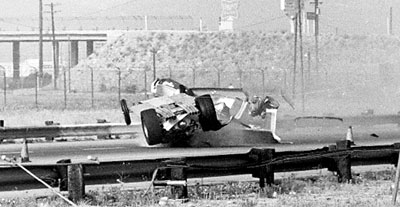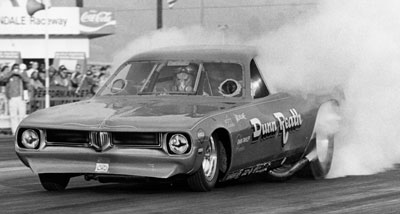

Rear-Engine Funny Cars
ItŌĆÖs funny the things we take for granted. Most of the readers of this column have their own vast mental encyclopedias of drag racing knowledge, so I try not so much to regurgitate the history they already know by heart but to fill in the details that have either been somehow swept to the dark corners of our memories or to bring to light new information that I discover, hence the columnŌĆÖs tagline: The stories behind the stories.
Today, though, the behind part of the story concerns the engine as it relates to our fiberglass friend, the Funny Car. Reader Dave Gibson, of Guelph, Ont., who has been following the sport since the early 1980s, about had a coronary when I mentioned rear-engine Funny Cars of Jim Dunn and Burt Berniker last week.
ŌĆ£Excuse me ... what?ŌĆØ he wrote. (I imagine him sputtering his morning coffee all over his monitor.) ŌĆ£A rear-engine Funny Car bandwagon? Have I been on dope? This is the first time I have ever heard of such an animal. Who, when, where, and what happened? What a strange idea. Looking at the picture, the first question is where is the supercharger air intake? WhatŌĆÖs the best e.t. and speed? Who championed? Why go this direction anyway? Where are they now?ŌĆØ
So many questions, Dave. First things first: The reason you donŌĆÖt remember them has nothing to do with your pharmacological hobbies but more your timing. The rear-engine revolution was pretty short-lived ŌĆōdying out in the mid-1970s ŌĆō and definitely didnŌĆÖt revolutionize the sport the way that the rear-engine dragster did.
Funny Car veteran Dunn probably did more to enhance the breedŌĆÖs reputation when he drove his back-motor Barracuda to victory at the 1972 Supernationals at Ontario Motor Speedway, the first ŌĆō and still only (and undoubtedly ever) ŌĆō national event victory by a rear-engine car, and had it featured in the quarter-mile cult classic film, Funny Car Summer.
Although Dunn was hands-down the most successful rear-engine Funny Car campaigner, he certainly wasnŌĆÖt the first.
 Tom McEwen's rear-engine Hemi 'Cuda took flight in its maiden outing at Lions. |
 |
Even though the Funny Car class wasnŌĆÖt officially recognized until years later, the Hemi 'Cuda of Tom McEwen and Lou Baney is a good place to start. The enterprising duo shoehorned a blown Hemi on 80 percent nitro into the backseat of a ŌĆÖ65 Barracuda, and off they went ŌĆ” literally. In one of its first test sessions at Lions Drag Strip, the high-sitting 'Cuda took flight and crash-landed.
"We didn't know about shapes and spoilers," McEwen told me a few years ago. "We were making short test passes and shutting off, and we kept going faster and faster. At about 160 mph, it had enough air going underneath and over the top that it created lift and took off. I could see the fence posts and pole going by. I shut off and pulled the chutes, then it twisted and came down on its side, then rolled on its roof. It skidded on its roof and ground through the roof to the roll bar and set the headliner on fire."
McEwen wasnŌĆÖt hurt, and he and Baney built a newer and lower version, which later was sold to Fred Goeske, who ran it as a match race machine with limited success.
Although it also didnŌĆÖt have a flip-top Funny Car-style body, Top Fuel racer Maynard RuppŌĆÖs Chevoom did sport a blown Chrysler Hemi in the rear-seat area of the bright yellow ŌĆÖ66 Chevelle. Rupp entered and exited the fiberglass-shelled creation through the doors, which opened, as did the hood and the trunk.
 Doug Thorley's rear-engine Javelin 1 also ended up all wadded up after Bob Hightower flipped it in the lights at Irwindale in June 1969. |
 |
Eddie Pauling, who later gained fame as the driver of Johnny LoperŌĆÖs hard-running flopper in the mid-1970s, was an early experimenter in the rear-engine division with his flip-top Dodge Dart and Mercury Cougar, the OlŌĆÖ Whine Maker, which featured a 392 Chrysler Hemi behind his head and ran in the mid-eights at 180-mph range in 1966 and 1967.
Header manufacturer Doug Thorley made the next big splash with a mid-engine car, the Javelin 1, built in 1968 by Woody Gilmore and cloaked beneath an AMC Javelin body. It originally ran an AMC engine but later was converted to 392 power, then a late-model Hemi. Among its crew was Dunn, who was helping his buddy Gary Slusser (who, 20 years later, would tune Joe Pisano's car, driven by Dunn's son, Mike, to national-record-breaking speeds; small world, eh?).
Like the Hemi 'Cuda, Javelin 1 was star-crossed. Thorley initially drove his car, which Norm Weekly also piloted. Dunn, who was between rides then, reportedly nearly drove the car, but he would have had to have quit his job at the fire department, so he backed out. Bob Hightower finally flipped it overbackward in the lights at Irwindale Raceway in June 1969.
Once Don Garlits proved the value and safety of the rear-engine design in a dragster, it was only natural that the Funny Car drivers would give it a go as well.
 Woody Gilmore, left, built two rear-engine floppers for Jim Dunn. |
 |
 |
 Dunn alternated drivelines, sometimes using a reverser and sometimes relying on crew power to get his 'Cuda back to the starting line after a burnout. |
When Dunn and longtime friend and supporter Joe Reath commissioned Gilmore to build their rear-engine Barracuda a few years later, Dunn said it was not influenced by his experience with Thorley's car, but by the fear of a fire. As a professional firefighter, he had a healthy dose of respect for fire's fickle finger. I interviewed Dunn at length a few years ago for a National DRAGSTER story, which I dug out for reference and his still-applicable quotes.
DunnŌĆÖs car made its official debut at Lions Drag Strip's Grand Premiere in 1972, where it wheelstood immediately and never made it down the track. Prior to the Winternationals, Dunn and Gilmore loaded the front end with 50 pounds of weight and not only qualified (albeit 16th with a 7.15, far behind polesitter Pat Foster's 6.84), but also upset Mike Burkhart in round one. Dunn lost to Jake Johnston in Gene Snow's car in round two but received the meet's Best Engineered Car award.
Dunn scored runner-up honors at the March Meet that year (a broken clutch finger after his final-round burnout gave Ed McCulloch a bye run), and he was runner-up (to Dave Beebe) at Sacramento RacewayŌĆÖs divisional event after again breaking on his final-round burnout. Dunn scored his first major win in the car at the Division 7 event at UtahŌĆÖs Bonneville Raceway. He ended the year with the SuperNationals victory, winning the historic final on a Foster red-light.
Many others tried to duplicate DunnŌĆÖs success, some of which you can see in the gallery at the bottom of this column. YouŌĆÖll also see a variety of methods used to handle the induction, which ranged from nothing at all (other than, presumably, air drawn through the open side windows) to roof-mounted scoops or, in the case of DunnŌĆÖs cars, vents drawing air through the windshield. One thing they did have in common is that most met quick and inglorious ends due to the fickle handling nature of the cars and driver error.
"You had to be a real chicken," said Dunn. "When you thought it was moving, you'd better be going the other way already. The car would go straight as an arrow four runs in a row, and then on the fifth run, that son of a bitch would turn left; four runs, and it would turn right. It was like a go-kart; my feet were on the front axle. It was scary. It did things for no reason with no warning."
Dunn had plenty of experience with spooky-handling cars from his years in the Dunn-Merritt-Velasco altered; he estimated that of the more than 100 runs he made, only two were done without lifting at least once.
Dunn's car was powered not by the popular 426 Hemi but rather an early 392 Chrysler, and Dunn switched between a direct-drive setup and a conventional two-speed transmission. At national events and points meets, he would run the performance-enhancing two-speed (good for about a tenth, Dunn recalled), but the car's layout did not allow room for both a transmission and a reverser, so he had to be pushed back to the starting line (a common practice in Top Fuel then). At match races, he'd run just the reverser so that he could do track-length burnouts in the high-gear mode. Although Dunn never ran the full national event tour, he match raced up and down the West Coast.
Dunn opened 1973 with the '72 car by winning Irwindale's Grand Premiere and was runner-up at the trackŌĆÖs 64 Funny Car race, and he debuted a second rear-engine car later that year, built lower and with a more forgiving engine placement. His season highlight was a victory at IrwindaleŌĆÖs divisional event. He finished the season with the rear-engine car and returned to a conventional car in 1974. DunnŌĆÖs best time with the rear-engine car was an impressive 6.44.
We know that no other rear-engine car ever won a national event, and, according to my records, no other rear-engine cars even qualified, though Dennis Geisler certainly tried hard with BernikerŌĆÖs Hindsight car at the 1975 Winternationals, which he flipped just off the starting line in qualifying. (IŌĆÖll cover the Hindsight saga Friday.)
In summary and eulogy, Dunn said of the breed, "Even though the rear-engine car was safer and we made a lot of money on it ŌĆö we had every match race we could handle ŌĆö it was just too unstable. It really took a steady hand. That was the problem with those cars and why they didn't work. The guys who couldn't make 'em work either didn't have the driving ability or the mechanical ability. I know that sounds cold, but that's the way it was."
Here's a gallery of some other rear-engined cars; most didn't leave behind much more than a memory.

Eddie Pauling's Ol' Whine Maker Cougar ran 8.0s at 180 mph in 1966-67.

Another look at Doug Thorley's Javelin 1 and its front-hinged body.

Believe it or not, John Force got his Funny Car start in this ex-Jack Chrisman/ex-Roy Maheu Mustang that featured a side-mounted 427 SOHC Ford and chain drive. It was not successful.

The Wayne Mahaffey-driven Holt & Mahaffey Alabamian Vega panel truck, built by Don Hardy, was destroyed early in its life when a front spindle broke at speed at Huntsville Dragway (Ala.) after a dozen runs in 1973.

Dave Bowman enjoyed a small degree of success with his California Stud Vega wagon, taking runner-up honors at the 1973 PDA Meet at Orange County. Bowman built the chassis; unlike most rear-engine cars, the body was hinged at the rear.

Ken Riehle's Hellfire 1970 Camaro, driven by Lew Arrington, burned to the ground in its first season.

Robert Contorelli's 1973 Mustang, built by Roy Fjastad, was pretty but had little success.

The Motta & Williamson Challenger, built by Kent Fuller and driven by Jack Motta, featured a fully independent front suspension as opposed to the typical tube axle.

Bert Berniker's Hindsight may be the most infamous rear-engine Funny Car ever; on Friday.




















































